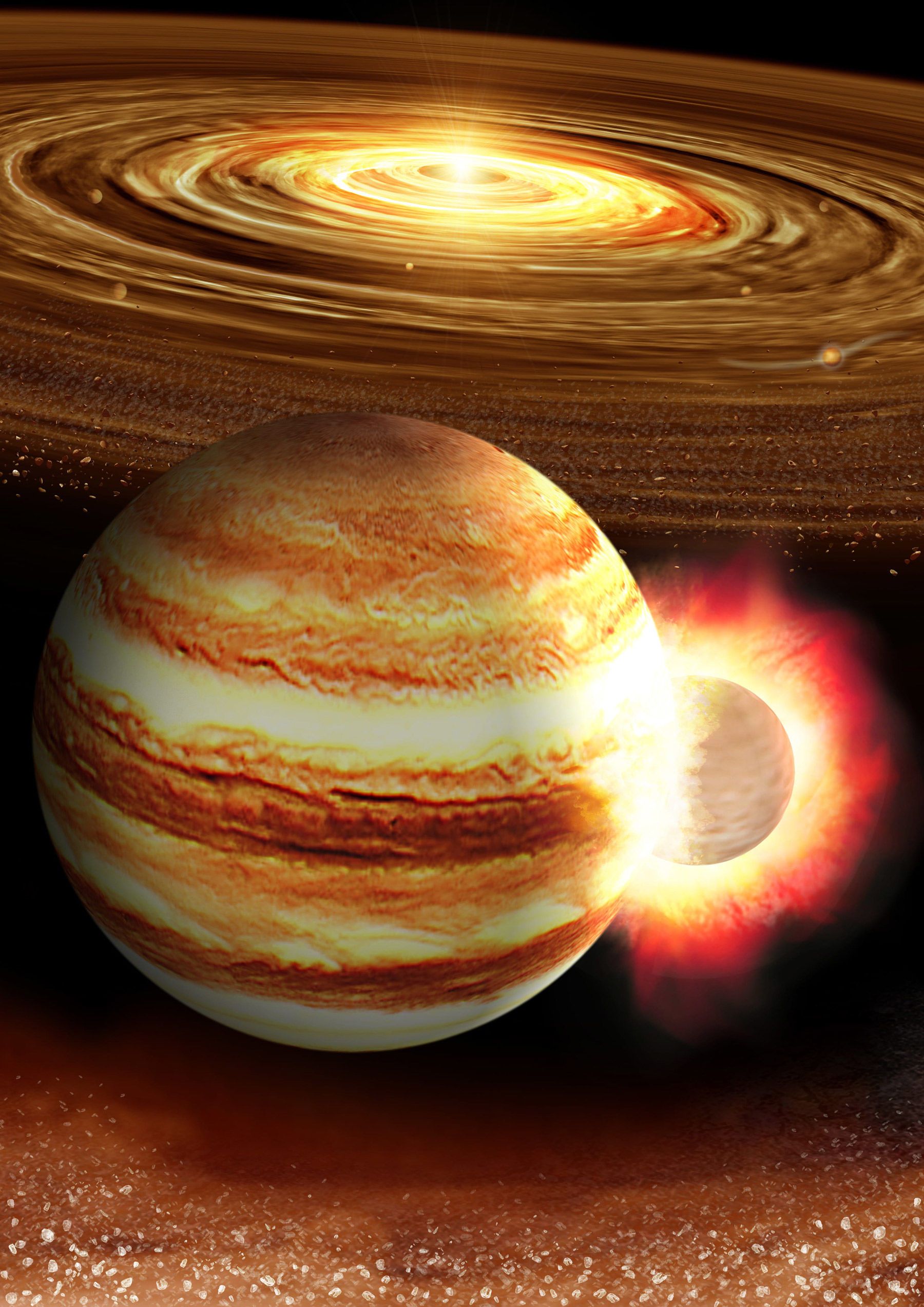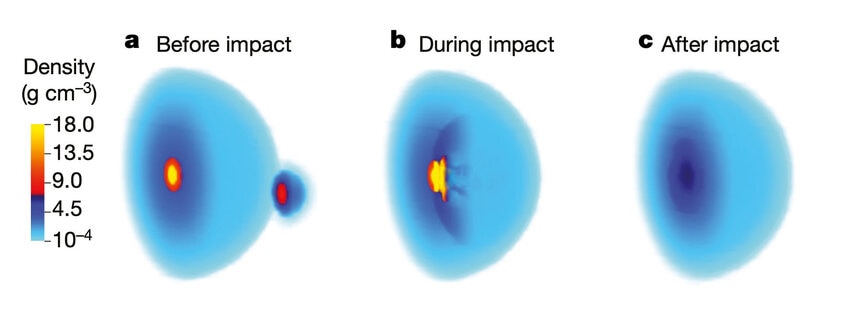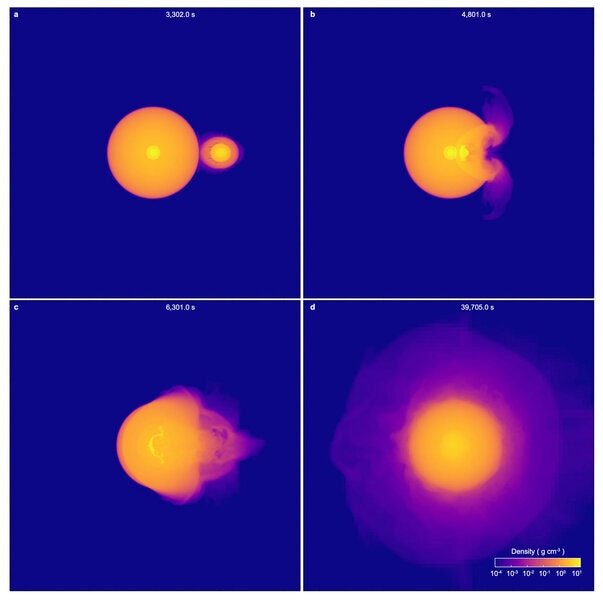Create a free profile to get unlimited access to exclusive videos, sweepstakes, and more!
Was Jupiter's core nearly destroyed by a massive planetary impact while it was still forming?

Jupiter is a behemoth. It has over 300 times Earth’s mass, is nearly 11 times wider than our fair world, and is so huge that, by volume, every other planet in the solar system could fit inside it.
Still, it has a core problem.
I mean that literally. Well, in that we have a problem not understanding its core. Different physical models of how Jupiter formed over 4 billion years ago predict different things for its interior. One set of models predicts it should have a distinct, well-organized core at least ten times the mass of Earth, maybe much larger, while another set of models predicts Jupiter won’t even have a core at all! The issue is, it’s nearly impossible to figure out which one of them is correct by observing Jupiter from Earth.
That’s a big reason why scientists built the Juno probe. As I’ve written before:
One of the biggest questions scientists hope Juno will answer actually sounds pretty simple: Does Jupiter have a core? The Earth, for example, has a dense nickel/iron core, formed as those heavy metals fell to the center of our planet as it cooled. Jupiter, though, may not have one at all!
I always assumed it had one, but when I was researching Jupiter for my Crash Course Astronomy episode on it I found that may not be the case. It depends in part on how Jupiter itself formed. In the early solar system, a lot of material starting clumping together to form bigger and bigger objects, going from grains of sand to rubble to boulders to things which were starting to look like planets, called protoplanets. If a bunch of those smashed together to form Jupiter — creating it from the bottom up, so to speak — then yeah, it should have a dense rocky/metal core, probably more massive than our own planet.
It’s also possible Jupiter collapsed directly from the disk of gas and dust surrounding the Sun — from the top down. If that’s the case then it won’t have a core. I’ll note that it’s possible it could have started with a core, but it got eaten away by currents of hot metallic hydrogen deep inside the planet as well.
The presence of a core or lack thereof will change the way Jupiter’s gravitational field is shaped, and this in turn will affect Juno’s orbit. By carefully measuring the spacecraft’s trajectory, this jovian riddle can be solved!
After a half dozen or so orbits of Juno, scientists discovered something unsettling: Jupiter appears to have a core, but it’s … fuzzy. Diluted. As if instead of a distinct layer of rock and metals in the middle, it’s all mixed up with the stuff around it, without a real border between them.
That’s irritating. Neither model is right!
Or maybe they’re not complete.
Artwork showing a massive planet impacting the protoJupiter while the solar system was still forming. Credit: K. Suda & Y. Akimoto/Mabuchi Design Office, courtesy of Astrobiology Center, Japan
Artwork showing a massive planet impacting the protoJupiter while the solar system was still forming. Credit: K. Suda & Y. Akimoto/Mabuchi Design Office, courtesy of Astrobiology Center, Japan
A team of astronomers has come up with an interesting idea to solve this dilemma: Jupiter started out with a nice core, but then another giant planet came along and collided with it! The impacting planet drilled its way through Jupiter’s atmosphere and slammed into Jupiter’s core, disrupting it completely. After a while some of it settled back down into the center, but a lot of it got mixed up with the atmosphere surrounding it.
Well. At least they’re not thinking small.
All of this, they posit, happened while Jupiter was still forming billions of years ago. It gained mass little by little as smaller planetesimals (already-formed bits in the early solar system, up to a size of about a hundred kilometers across) came together and grew. Once it hit a certain mass its gravity was strong enough to start actively drawing material in; most of this was hydrogen and helium, so this is called the runaway gas accretion phase. By this time Jupiter was already forming a decent-sized core and had a thick atmosphere around it.
For their model they assumed Jupiter has about the same mass it does today, with a core made of ice and rock with about ten times Earth’s mass. The interloper would have been about ten times Earth’s mass in total, with a core of about 8 Earth masses of rock and ice and an atmosphere of hydrogen and helium making up the rest.
They then slammed the smaller planet into protoJupiter at a speed of a whopping 46 kilometers per second, which is how fast something would hit given the mutual gravity of the two planets. They then played with the model a bit to see how changing things changed what happened to Jupiter’s core.
For a grazing (off-center) impact, they found that in general the incoming planet is torn apart in the atmosphere, and doesn’t affect the core. They also found that if the planet is too small (like Earth’s size) it disintegrates before ever reaching the core.
But, if the planet is massive enough and hits head-on, it can then bore its way through Jupiter’s atmosphere and impact the core. The collision is so violent the core essentially explodes. It and the impactor are torn to pieces, which then mix with the lower part of Jupiter’s atmosphere. By the time things settle down, about a day later (!) the core is a huge distended fuzzy thing, much like we see it today.
A key part of their study shows that this state can last for billions of years. That’s important; if it settled down into a distinct core again in a few million years then the model wouldn’t accurately predict what we see now.
This is pretty interesting. I’ll note that this is a first stab at this sort of idea; there’s a lot left to figure out. One thing that bugs me a bit is that the outcome of the model is heavily dependent on the impact conditions. They had to fiddle with a lot of variables to get the answer to match present-day observations. That’s not a deal-killer, but it’s an indication that you have to be careful making firm conclusions based on the model. If you have to make things just right to get the conclusion you want, a lot of scientists will be rightfully skeptical.
But it does have a lot of positives to it — in fact, interestingly, in one way the fine-tuning issue is a pro for the model. Saturn is very different internally than Jupiter, which is a little weird. You’d expect them to be pretty similar if they formed in the same region of the solar system. But maybe Saturn got hit as well, and because the impact was different (maybe the impactor was a different mass, or the impact angle was offset a bit) the outcome was really different. So the sensitivity of the model to different variables actually makes sense for that.
Astronomers love their impacts to explain things, mostly because they do a really good job explaining so much! So I’m confident others will take this idea and run with it, and we’ll see more discussion about it. Hopefully more Juno data (it’s still orbiting Jupiter and sending back tons of observations) will also lead to better models, more refinement, and — the ultimate goal — a more complete understanding of this ridiculously huge and ridiculously fascinating gigantic neighbor of ours.

















